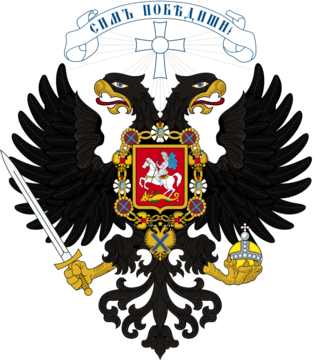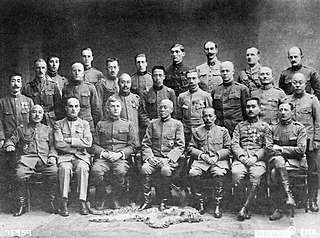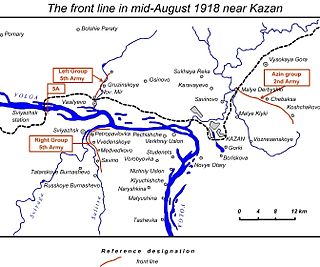
The Russian Civil War was a multi-party civil war in the former Russian Empire sparked by the overthrowing of the social-democratic Russian Provisional Government in the October Revolution, as many factions vied to determine Russia's political future. It resulted in the formation of the Russian Socialist Federative Soviet Republic and later the Soviet Union in most of its territory. Its finale marked the end of the Russian Revolution, which was one of the key events of the 20th century.

The Czechoslovak Legion were volunteer armed forces comprised predominantly of Czechs and Slovaks fighting on the side of the Entente powers during World War I and the White Army during the Russian Civil War until November 1919. Their goal was to win the support of the Allied Powers for the independence of Lands of the Bohemian Crown from the Austrian Empire and of Slovak territories from the Kingdom of Hungary, which were then part of the Austro-Hungarian Empire. With the help of émigré intellectuals and politicians such as the Czech Tomáš Garrigue Masaryk and the Slovak Milan Rastislav Štefánik, they grew into a force over 100,000 strong.

The Committee of Members of the Constituent Assembly was an anti-Bolshevik government that operated in Samara, Russia, during the Russian Civil War of 1917–1922. It formed on June 8, 1918, after the Czechoslovak Legion had occupied the city.

Polish 5th Siberian Rifle Division was a Polish military unit formed in 1919 in Russia during the aftermath of World War I. The division fought during the Polish-Soviet War, but as it was attached to the White Russian formations, it is considered to have fought more in the Russian Civil War. Its tradition was continued in the Polish Army as the 30th Infantry Division.

The Allied intervention in the Russian Civil War consisted of a series of multi-national military expeditions that began in 1918. The initial impetus behind the interventions was to secure munitions and supply depots from falling into the German Empire's hands, particularly after the Bolsheviks signed the Treaty of Brest-Litovsk, and to rescue the Allied forces that had become trapped within Russia after the 1917 October Revolution. After the Armistice of 11 November 1918, the Allied plan changed to helping the White forces in the Russian Civil War. After the Whites collapsed, the Allies withdrew their forces from Russia by 1925.

The Provisional Siberian Government, was an ephemeral government for Siberia created by the White movement.

The American Expeditionary Force, Siberia was a formation of the United States Army involved in the Russian Civil War in Vladivostok, Russia, after the October Revolution, from 1918 to 1920. The force was part of the larger Allied North Russia intervention. As a result of this expedition, early relations between the United States and the Soviet Union were poor.

The White Army or White Guard, also referred to as the Whites or White Guardsmen, was a common collective name for the armed formations of the White movement and anti-Bolshevik governments during the Russian Civil War. They fought against the Red Army of Soviet Russia.

The Siberian intervention or Siberian expedition of 1918–1922 was the dispatch of troops of the Entente powers to the Russian Maritime Provinces as part of a larger effort by the western powers, Japan, and China to support White Russian forces and the Czechoslovak Legion against Soviet Russia and its allies during the Russian Civil War. The Imperial Japanese Army continued to occupy Siberia even after other Allied forces withdrew in 1920.

Mikhail Konstantinovich Diterikhs served as a general in the Imperial Russian Army and subsequently became a key figure in the monarchist White movement in Siberia and the Russian Far East area during the Russian Civil War of 1917–1923.

The Japanese Siberian Intervention of 1918–1922 was a dispatch of Japanese military forces to the Russian Maritime Provinces, as part of a larger effort by western powers and Japan to support White Russian forces against the Bolshevik Red Army during the Russian Civil War. The Japanese suffered 1,399 killed and another 1,717 deaths from disease. Japanese military forces occupied Russian cities and towns in the province of Primorsky Krai from 1918—1922.

The Legione Redenta was an Italian military formation that participated in the Siberian intervention during the Russian Civil War. It was formed from 2500 prisoners of war who had been captured by the Russians from the Austro-Hungarian Army.

The revolt of the Czechoslovak Legion comprised the armed actions of the Czechoslovak Legion in the Russian Civil War against Bolshevik authorities, beginning in May 1918 and persisting through evacuation of the Legion from Siberia to Europe in 1920. The revolt, occurring in Volga, Ural, and Siberia regions along the Trans-Siberian Railway, was a reaction to a threat initiated by the Bolsheviks partly as a consequence of the Treaty of Brest-Litovsk. One major secondary consequence of victories by the Legion over the Bolsheviks was to catalyze anti-Bolshevik activity in Siberia, particularly of the Committee of Members of the Constituent Assembly, and to provide a major boost for the anti-Bolshevik or White forces, likely protracting the Russian Civil War.
The Battle of Barnaul was a series of engagements from 13 June to 15 June 1918, during the Russian Civil War. The battle involved several; different factions in the Siberian region. The Red Guards and White movement were the main combatants.

The People's Army of Komuch was an anti-Bolshevik army during the Russian Civil War that fought in the Volga Region from June to September in 1918. It was established by the Socialist Revolutionary Party and led by Vladimir Kappel.
The Simbirsk Operation was the Bolshevik Red Army's offensive against Vladimir Kappel's anti-Bolshevik People's Army of Komuch and Czechoslovak Legion. The attack came at Simbirsk, on the Eastern Front of the Russian Civil War, in September 1918. The Bolsheviks re-took the city, forcing Kappel's retreat to Ufa, where his force was absorbed by the Siberian Army.

The Siberian Army was an anti-Bolshevik army during the Russian Civil War, which fought from June 1918 – July 1919 in Siberia – Ural Region.
The Eastern Front was a front of the Red Army during the Russian Civil War, formed on June 13, 1918 and disbanded on January 15, 1920.

The Russian State was a White Army anti-Bolshevik state proclaimed by the Act of the Ufa State Conference of September 23, 1918, “On the formation of the all-Russian supreme power” in the name of “restoring state unity and independence of Russia” affected by the revolutionary events of 1917, the October Revolution and the signing of the treaty of Brest-Litovsk with Germany.

An index of articles related to the Russian Revolution and the Russian Civil War period (1905–1922). It covers articles on topics, events, and persons related to the revolutionary era, from the 1905 Russian Revolution until the end of the Russian Civil War. The See also section includes other lists related to Revolutionary Russia and the Soviet Union, including an index of articles about the Soviet Union (1922–1991) which is the next article in this series, and Bibliography of the Russian Revolution and Civil War.
















